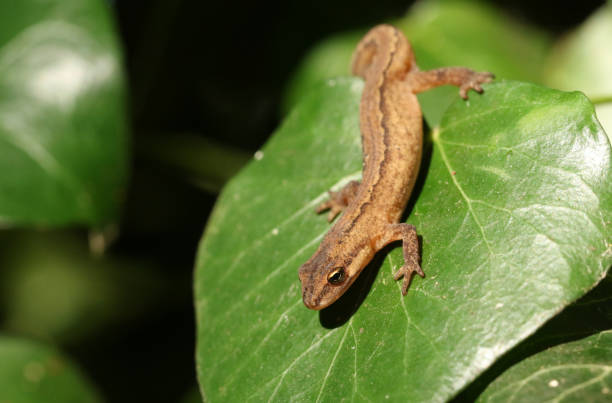Helpful Guides on each Category

How often do Newts come up for air? – this is a question asked by many admirers of this amphibian. Newts, with their beautiful mix of colours and amphibious lifestyle, have captivated the curiosity of nature enthusiasts.
Newts are amphibians and breathe through their skin, so they don’t need to come up for air as frequently as other aquatic animals. They stay submerged for extended periods but still come to the surface periodically to breathe. The frequency varies, but it’s generally every 10-30 minutes.
Imagine a creature that remains underwater, only to break the surface and gulp in a breath of fresh air. This is the newt, but while they seem equally at home in both worlds, how often do newts take that leap from liquid to air?
To better understand the respiratory behaviour of newts, let’s delve into the very essence of their existence. This blog post addresses the enigmatic question: “How often do newts come up for air?” and touches on other aspects of this animal.
How Do Newts Breathe?

I’ve even heard people ask “Do newts breathe air or water?”. Newts, are amphibians that stay both on land and in water, so their respiratory adaptations enable them to breathe both air and water! Yes, you read that right. They have a dual-breathing system that allows them to adapt to their ever-changing environments.
In their larval stage, newts have feathery gills sprouting from behind their heads. These gills act like miniature filters, extracting oxygen dissolved in the water and sending it straight to their bloodstream. (Imagine them as tiny scuba suits built-in!)
As they metamorphose into adults, newts develop a pair of primitive lungs, allowing them to gulp in fresh air at the surface. These lungs, though not as complex as human lungs, extract oxygen from the air and deliver it to their bodies. So at the adult stage, Newts need lungs to breathe air through.
How Long Do Newts Stay Underwater?
Ah, the million-dollar question! Unfortunately, there’s no one-size-fits-all answer to how often newts come up for air. Their air-breathing schedule is controlled by many factors:
Environmental Factors
- Oxygen levels in the water: As mentioned before, low oxygen in the water pushes newts to come up for air more frequently. Think of it as an oxygen alarm bell ringing in their skin!
- Water temperature: Warmer water holds less dissolved oxygen, so newts need to “refill” their air tanks more often in tropical habitats compared to cooler environments.
- Presence of plants: Plants release oxygen during the day through photosynthesis, potentially offering newts a little extra breathing room in well-planted aquariums.
Newt-Specific Factors
- Species: Different newt species have varying lung capacities and skin thicknesses, influencing their reliance on air and water for respiration.
- Activity level: Active newts, like those hunting or fleeing predators, burn more oxygen and require more frequent air breaks.
- Health: Sick or injured newts might have compromised respiratory functions, needing to come up for air more often.
- Skin Surface Area: Newts with larger skin surfaces have a greater area for oxygen absorption, enabling them to stay submerged for longer. Imagine them having bigger “windows” to pull in the oxygen from the water.
- Hibernation: During hibernation, newts’ metabolism slows down significantly, requiring less oxygen. This can allow them to stay underwater for extended periods, sometimes even months, in oxygen-rich environments like freshwater springs. Where they hibernate plays a crucial role. Deep underwater hibernation offers more favourable oxygen levels compared to shallower areas.
How do I know when a newt needs air?

So, how can you get a glimpse into this underwater-to-airtime ratio? While there’s no magic number, here are some signs that a newt might be looking for a breath of fresh air:
- Head bobbing near the water surface: This could be their way of testing the oxygen levels just above the water.
- Sniffing at the air interface: They’re using their nostrils to get a whiff of that sweet, sweet oxygen.
- Breaking the surface with their nostrils exposed: The ultimate air grab, ready to fill those precious lungs.
While the frequency of their air appearances remains a variable, one thing’s for sure: newts are masters of balancing their aquatic and aerial breaths.
The Aquatic Life of Newts
Newts primarily dwell in freshwater habitats like ponds, lakes, and streams. They find refuge amongst aquatic vegetation, rocks, and fallen leaves, enjoying the cool, moist environment. This reliance on water is reflected in their physical features, from their streamlined bodies to their webbed feet.
Newts seamlessly blend between aquatic and terrestrial habitats, but it’s their aquatic phase that truly reveals their remarkable adaptations and the intricate connection between their breathing and their underwater environment.
Quick Life Cycle of Newts
- Eggs: Deposited underwater on plants or rocks, newt eggs are encased in jelly-like capsules. At this stage, they rely on dissolved oxygen in the water for respiration.
- Aquatic Larvae: Hatching from the eggs emerge tiny tadpole-like larvae. Equipped with feathery external gills, they extract oxygen directly from the water through these delicate structures.
- Metamorphosis: As they grow, larvae undergo a remarkable transformation. Gills gradually disappear, replaced by primitive lungs and developing limbs. The skin, with its moist surface area, plays an increasingly important role in cutaneous respiration, absorbing oxygen from the water or air.
- Adult Newts: Finally, the metamorphosis culminates in adult newts, able to breathe both underwater and on land. Their lungs allow them to gulp in air at the surface, while their skin continues to absorb oxygen throughout their body.
Respiratory Adaptations
The beauty of newts lies in their amphibious respiration. They possess a dual-breathing system, effortlessly switching between:
- Gill breathing: In their larval stage, gills dominate, extracting oxygen directly from the water.
- Lung breathing: Adult newts develop primitive lungs, allowing them to gulp in air at the surface for oxygen needs.
- Cutaneous respiration: Their thin, moist skin acts as a secondary respiratory organ, absorbing oxygen from both water and air throughout their body.
Tips for Newt Enthusiasts
- Before inviting a newt into your life, delve into the specific needs of your chosen species. Research their ideal habitat size, water quality parameters, dietary requirements, and compatible tank mates.
- Provide an aquarium that reflects their amphibious nature. Create a spacious aquatic zone with clean, well-filtered water and plenty of submerged plants for hiding and oxygenation. A land area equipped with rocks, driftwood, and live or artificial plants is crucial for basking and air-gulping.
- Maintain clean and optimal water parameters by regularly testing and adjusting pH, temperature, and ammonia levels.
- Newts thrive on a diverse diet of live or frozen prey like bloodworms, brine shrimp, and chopped earthworms.
- Newts are fragile creatures. Minimize handling and always support their body fully with damp hands to avoid injuring their delicate skin.
- Consider the water source and surrounding environment of your chosen newt species. Replicate key elements like water flow, plant types, and hiding spaces to create a familiar and comfortable atmosphere.
- Ensure proper water circulation and aeration to maintain adequate oxygen levels throughout the tank. This is especially important in warmer environments or for species with higher oxygen demands.
- Create land areas with access to natural sunlight or UV lamps to facilitate vitamin D synthesis, crucial for bone health and overall well-being.
- Maintain optimal water temperature ranges specific to your Newt species. Cooler temperatures generally favour higher oxygen levels, while warmer environments might necessitate more frequent air-gulping.
Newt Cool Adaptations

Newts, those amphibious masters of water and air, boast a treasure trove of fascinating adaptations, especially when it comes to their unique breathing prowess. Beyond their standard lung-and-skin combo, they’ve evolved some truly cool tricks to optimize their oxygen intake in both aquatic and terrestrial environments. Let’s see these remarkable respiratory adaptations:
Skin Folds
Imagine a superhero cape but for oxygen! Some Newt species, like the rough-skinned newt, possess elaborate skin folds along their bodies. These folds increase the surface area of their skin, providing more “real estate” for gas exchange. When submerged, water flows over these folds, facilitating the diffusion of oxygen into their bloodstream. It’s like having built-in mini gills right on their skin!
Tail Twists
Newts aren’t just graceful gliders; they’re also expert oxygen pumps! Some species, like the fire-bellied newt, can actively undulate their tails when underwater. These rhythmic movements create mini water currents, drawing oxygen-rich water towards their skin folds and gills, boosting their oxygen intake. Think of it as a personal underwater turbocharger!
Gular Flaps
Ever seen a newt with a puffed-up throat? That’s not just a dramatic display; it’s a clever respiratory tactic! Species like the warty newt have specialized throat pouches called gular flaps. When submerged, they can pump these flaps, drawing water into their mouths and forcing it over their skin folds, effectively increasing oxygen absorption. It’s like a personal underwater bellows system!
Pleated Skins
Not all newt skins are smooth and simple. Some, like the palmate newt, have intricate skin folds called pleats. These pleats increase the surface area of their skin even further, making them even more efficient at absorbing oxygen from the water. Imagine them wearing a built-in oxygen-boosting suit!
Fire-bellied Adaptation
Remember those fire-bellied newts, the underwater tail-twisters? They have another trick up their sleeve! Their bellies are brightly coloured for a reason.
The red colouration helps absorb oxygen directly from sunlight, giving them an extra respiratory boost on sunny days. Talk about soaking up the rays, literally!
More Interesting and fun facts about Newts here
Read also
Faqs
Do newts need oxygenated water?
Yes, newts require oxygenated water, particularly in their larval stage when they still breathe through gills. Low oxygen levels can be detrimental, forcing them to come up for air more frequently and putting stress on their delicate skin. Adequate water aeration and maintaining good water quality are crucial for their well-being.
Do newts lose their gills?
As newts undergo metamorphosis, their external gills gradually disappear and are replaced by primitive lungs. This allows them to switch from primarily water-based respiration to a blend of air and water breathing. However, their skin continues to play a significant role in absorbing oxygen throughout their lives.
Should I put a newt in water?
If you encounter a newt in your backyard or find one in nature, it’s best to leave it alone and observe it from a distance. Handling and transporting newts can be stressful for them, and their habitat preferences vary depending on the species. If you’re concerned about its well-being, research the local newt species and contact wildlife authorities or experts for appropriate guidance.
can Newts Drown?
While newts are well-adapted to both aquatic and terrestrial environments, they can drown if trapped underwater for extended periods. This is particularly true for species with low lung capacity or in situations where the water is stagnant and lacks sufficient oxygen. Observe newts with care and ensure their ability to access both water and land for their breathing needs.
What time of day are newts most active?
Newt activity depends on various factors like species, habitat temperature, and prey availability. Generally, they tend to be more active during dusk and dawn when temperatures are cooler and humidity is higher. However, some species can also be seen foraging or exploring during the day, especially on cloudy or rainy days.



